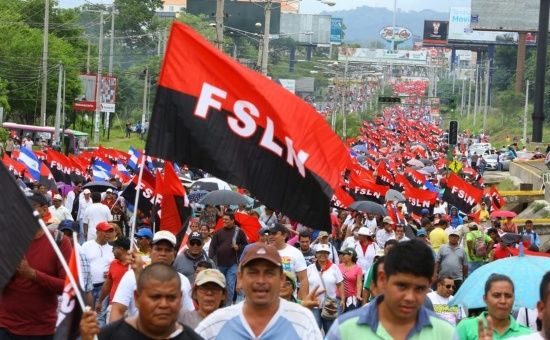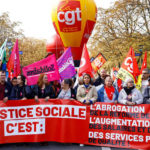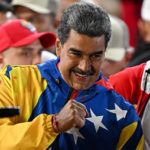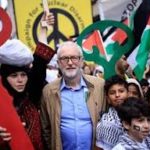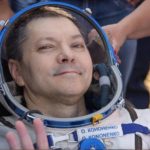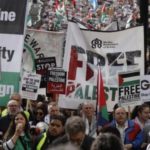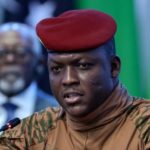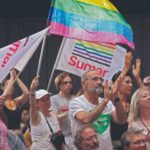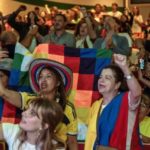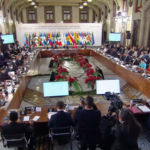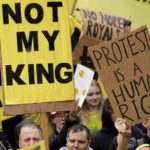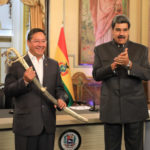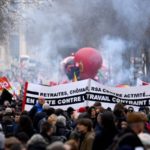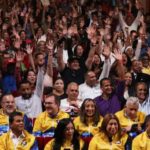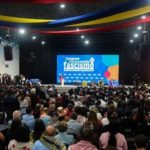THE RESOUNDING VICTORY FOR THE FSLN DEEPENS AND CONSOLIDATES THE DEVELOPMENT MODEL OF SOCIAL INCLUSION IN FORCE SINCE THE SANDINISTAS RETURNED TO GOVERNMENT IN 2006.
Presentation:
Daniel Ortega was inaugurated President of Nicaragua on 10.1.2022, along with Rosario Maria Murillo as Vice President. Officials and representatives of fifty countries were in attendance in Managua’s Revolution Square. Miguel Diaz-Canel represented Cuba, Nicolas Maduro Venezuela and Cao Jianming the National Assembly of China. The Biden government stayed away, but the USA were aptly represented by the many US solidarity, peace, human rights, academic and Black activists.
Nicaragua is now moving ahead: Relations with China, exit from OAS, end of ties with Taiwan, accords with Honduras, support for regional integration, down with the vicious US and EU sanctions, reparations for the 50,000 killed by the Contras, cooperation with Venezuela and Cuba. Forward to the unity of the oppressed nations!
NICARAGUA VOTED AGAINST NEOLIBERALISM
The elections in Nicaragua on November 7, 2021 marked a triumph for the Sandinista National Liberation Front (FSLN) with 75% of valid votes confirmed in front of hundreds of observers and journalists from around the world, including the United States and Canada. They were able to verify the development of this electoral process, and above all to note the intervention of a people conscious of the historical significance represented by this election.
The resounding victory for the FSLN deepens and consolidates the development model of social inclusion in force since the Sandinistas returned to government in 2006. The other way would have meant surrender to neoliberalism and its 5 political parties of opposition.
This was not just one more election. Nicaragua had become increasingly harassed and attacked by the United States and allies, Spain, Canada, Costa Rica and the whole European Union. These countries do not recognise the electoral results that give victory to those they oppose. This applies in particular to Daniel Ortega who reversed the 1990 neoliberal policies of Violeta Chamorro, policies that destroyed all public gains of a socialist nature developed by the Sandinists after the triumph of the popular revolution on 19 July 1979.
During the disastrous three-term neoliberal period, the three US-backed presidents, Chamorro, Alemán and Bolaños, dismantled the free public education system. After the start of a crusade against illiteracy with methods developed by the Brazilian Paulo Freire, the illiteracy returned that the Sandinista revolution had eradicated. With the swinging cuts in public education investment, teachers were not hired, favouring private schools including Catholic ones. With cuts in public health investments, only those who could afford it could access private clinics. The rest of the population had to go to public hospitals starved of funds and personnel. That period amounted to the continuation of the war of the “contras”. Whilst health and education plummeted, illiteracy, mass unemployment and begging grew, and the diseases that had been eradicated returned.
The Sandinistas are back through the ballot box because after their defeat, the masses did not remain passive. From the election of neoliberal presidents to elections rigged and manipulated by the United States, the FSLN continued its struggle against the disaster of colonial neoliberalism that was destroying Nicaragua.
Solidarity from Cuba and Venezuela
Since 2007, the country has once again prioritized public policies to rebuild free and universal education. It has rebuilt free public health with the support of Cuba which has trained hundreds of Nicaraguan doctors at the Latin American School of medicine in Havana.
Power cuts used to happen throughout Nicaragua when neo-liberalism ruled the state. The solidarity aid of Bolivarian Venezuela was decisive during this period. Several electricity production plants were installed with the help of Hugo Chávez, bringing normalcy to the country, taking it out of the darkness neoliberalism had willed.
With the Sandinista government, Nicaragua has changed its foreign policy. It has been attacked by the OAS – Organisation American States – which is a kind of US colonial ministry. Without leaving the OAS, Nicaragua joined Alba, Celac, Telesur, developed broad relations with several countries in the world; not only with Venezuela and Cuba, but also Russia with which it maintains excellent relations in various fields, including defence. Russia has given to Nicaragua 200 new buses now circulating in Managua.
The inclusive model
State investments within the framework of Sandinismo give priority to the concrete public policies that improve the living conditions. The heavy investments in electrification now cover 98% of the territory. The diversification of energy production has been undertaken to combine hydroelectricity, oil, biomass, geothermal energy (extracted from still active volcanoes), solar and wind power.
With the democratization of access to energy, lower costs and the introduction of social supports, the country’s economy has received a strong boost, especially in rural areas where food production is increasing. Self-sufficiency in food was achieved in 2017. The country has become an important exporter to Central America and Venezuela, but also to the USA which buy meat, coffee and gold from Nicaragua.
As Nicaragua has little industrial weight, agriculture made a leap forward in logistics and infrastructures for the transport of production. State investments led the country to the largest and most efficient road network in Central America, with a total of 25,000 km of paved roads, and in many cases lit, such as the road that connects Managua to León, one of the major cities with a university centre. Paved and modern roads connect nearly 100% of the country’s 143 municipalities.
Another major priority success of this inclusive model was to democratize access to drinking water, which already reaches 97% of the country, including the Caribbean coast that recently inaugurated a water-treatment plant in the city of Bluefields[1]. One of the great obstacles was effectively surmounted when interconnection was created between the Pacific coast and the Caribbean one – the latter long isolated from the country and accessible only by air. Drinking water is now practically accessible to the entire population of Nicaragua. It should be remembered in this regard that Brazil has 35 million inhabitants without access to drinking water, and that its economy – one of the largest in the world – has only 48% of basic sanitation.
Nicaragua is recognized for being among the 5 nations in the world with the greatest equity between women and men. In fact, in these last elections, a law required that there be 50% women candidates and 50% men, and with the women listed first on the ballots. In the National Assembly, the country’s parliament, there has long been parity between men and women, as well as in the composition of the ministerial posts.
In the policies to encourage women’s participation in the economy, and the cooperative sector especially, public funding is consciously directed to projects led by women. It is a concrete way to struggle against patriarchy. The latter is a colonial remnant combatted by Sandinism with the effective involvement of the women women in the Revolution.
The 2018 coup attempt
Faced with this model of development, the US attempted a coup with methods already tested in Venezuela (but where they were also defeated!), resorting to “guarimbas”[2], using violent action in the streets, the blockade of avenues and roads, and the burning of the state facilities mostly used by the population.
Young and armed persons financed from abroad started blocking avenues and roads under any pretext. They installed snipers in neighbourhoods from where they targeted members of the Sandinista police. After the start of such protests, young people would suddenly turn up from private universities, especially in the wealthier parts of Managua like La Rotonda, taking to the streets, with others appearing out of nowhere and calling for the resignation of Daniel Ortega.
The government tried to create negotiating tables to find a way out of a crisis that lasted more than three months. That crisis left more than a hundred dead – Sandinista police workers included – attacked by illegal armed groups. State universities were burned down, but not the private ones. Health centres were set on fire and stocks of medicines normally distributed free of charge were destroyed.
Groups of mercenaries used violence and torture against public employees in a terroristic manner reminiscent of events in Syria, Libya and Venezuela, while the capitalist media around the world accused the Sandinista government of dictatorship.
The involvement of the Catholic Church in this episode has been shameful. Clerics authorized the use of facilities, such as church towers and schools, to support armed groups in their actions against the Sandinista masses. This whole situation was aimed at stopping the November 2021 elections from happening. But the Sandinista protests became sufficiently powerful. The 2018 attempted coup was defeated without the government even using the army, but the tension remained in the air after that. The connivence of the business right-wing linked to the United States continued to grow until the elections, and the international attacks on the Sandinistas increased.
Zero tolerance for the coup plot
It is not surprising that Joe Biden is ordering the OAS to launch a campaign to delegitimize the presidential election in Nicaragua. This is a country of only 6.3 million inhabitants, several times invaded by the United States and where the US army intervenes in the electoral processes. What is surprising is to see how media hostility to Nicaragua still manages to find an echo in progressive ranks.
The propaganda media are now after Nicaragua; they do not accept its sovereignty, its independence, its model of social inclusion. But aren’t the organizers of media war all the same, like the Forbes magazine who accused Fidel Castro of being a billionaire, now going after Nicolás Maduro and Daniel Ortega? It is really surprising to see how progressive circles dare criticise the Sandinistas in countries where they are themselves losing their state enterprises, labour rights and public welfare.
More progress is necessary in agrarian transformation and in the control of the Covid 19 pandemic. But if the pandemic has made only 230 victims with 15,000 people infected in Nicaragua, it is thanks to the country’s community and participatory health system. This allowed for an intense popular mobilization with the families responding to the call of the Ministry of Health and taking the necessary preventive measures.
In Nicaragua, voting is not compulsory
The victory of the Nicaraguan people was prepared for when it organized its polling day of 7 November 2021 as a civic holiday. There were no riots and great logistical preparations instead. 230,000 electoral prosecutors and police officers were selected through tests where, to play the role, they had to show interest in the history of Nicaragua, the Constitution and the electoral legislation.
Observers from the United States and Canada followed the elections, visited polling stations, spoke to citizens of all colours and to opposition parties. They were able to demonstrate the fairness of the election as well as the enormous popular participation in peace and order. Many voters surmounted the fear of intimidation by travelling by boat or on horseback. Others walked long distances in the countryside to exercise consciously their right to vote. At the end of the electoral process, American and Canadian citizens published a letter challenging Joe Biden for his unproven statements published even before all the votes had been cast, where he made aggressive, disrespectful and threatening statements against Nicaragua.
The Sandinista victory could not be denied, with 75% of the valid votes and a 65% turnout from those entitled to vote. And this in spite of voting not being compulsory and the widespread North American campaign in favour of abstention.
Nicaragua’s right-wing has been split. A part of it supports conservative parties like its most important one, the Liberal Constitutionalist Party. This is the decades-old conservative association present in all the neoliberal governments that temporarily demolished the achievements of the Sandinista revolution.
It is surprising to see the Spanish Socialist Workers’ Party (PSOE) not recognizing the legitimacy of the election of Daniel Ortega and, on the contrary, not condemning the President of Brazil, Jair Bolsonaro.
The member parties of the São Paulo Forum[3] – the PT included, that recently signed declarations in defence of Sandinist Nicaragua – must discuss the democratic and progressive character of the social transformations taking place there. Here you have a Central American country that does not swell the caravans of refugees heading for the United States. For the contrary is the case. Nicaragua regularly receives the visit of Honduran and Panamanian citizens who rent buses to access Nicaragua’s health system and medicines too expensive and difficult to get in their own countries.
The media war
The media war against Nicaragua is relentless. The conservative opposition has its own media that operates tirelessly, accusing the Sandinistas of dictators, as they do against the Maduro government in Venezuela. These manipulations even influence progressive journalists who are beginning to take as references the editorial lines of the major business media conglomerates in the United States, such as CNN, the New York Times or the Spanish El País. It is necessary to open a debate of ideas in the progressive sphere, where criticism of what needs to be corrected is also included, whilst keeping in mind that people’s governments, wherever they are, are the target of non-stop disinformation campaigns.
Through this conscious vote, the Sandinist masses send to the world a message that contributes largely to stimulating the forces of the left; and to discussing throughout the world in more concrete terms the indispensable tasks to promote and ensure the achievements of popular governments.
From our special correspondent in Nicaragua – posadiststoday.com –10 Dec 2021
[1] Bluefields is the capital of the “South Caribbean Autonomous Region” in the Zelaya Department of Nicaragua. It used to be the capital of the Miskitu Kingdom circa 1848.
[2] Guarimbas: street barricades created by opposition groups with the aim of attacking, ransacking and killing.
[3] The Sao Paulo forum is a united front of left parties and organisations from Latin America and the Caribbean. It was launched in 1990 by the Workers Party (PT) of Lula.
